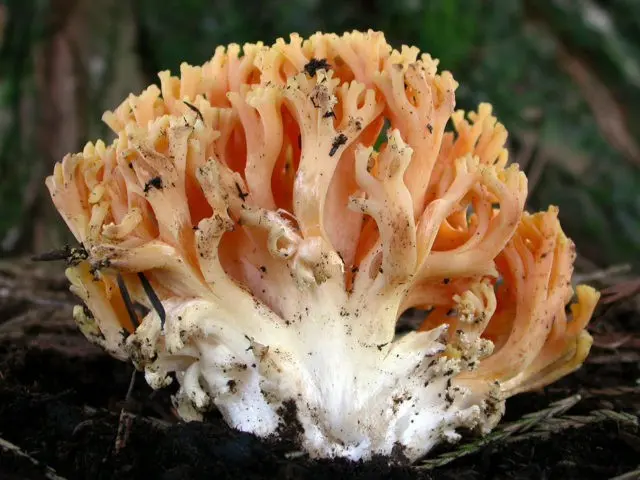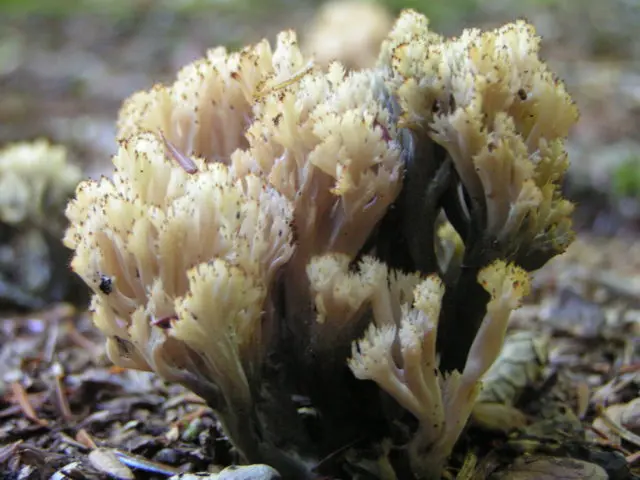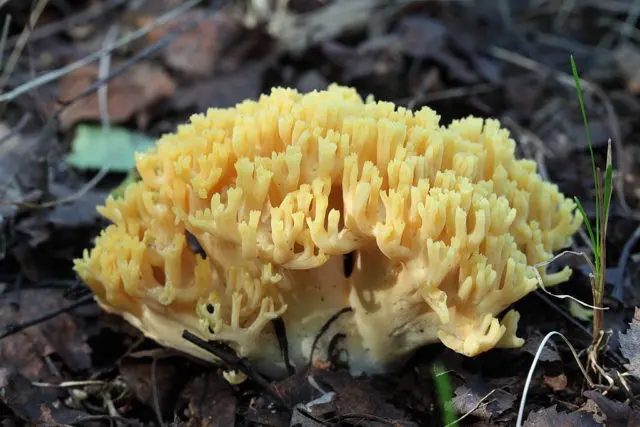Contents
Horned mushroom is an edible and very tasty mushroom, but it is difficult to distinguish it from poisonous counterparts. This is an endangered species, so collecting valuable specimens is not recommended.
Where do grape horns grow
The hornwort belongs to the department Basidiomycetes (Basidiomycota), the family Gomphaceae (Gomphaceae), the genus Ramaria (Ramaria).
Has a number of other names:
- ramaria grape;
- chicken feet;
- Clavaria или Corallium botrytis.
This is a very rare species, growing singly or in a colony. For the active development of the bunch-shaped fungus, special environmental conditions are required: the air temperature is not lower than +15 ° C, the soil warmed up to + 18 ° C.
In favorable conditions, the hornwort grows in a deciduous, pine or mixed forest, bears fruit from July to October. Most often, the mushroom can be found next to beeches, oaks and birches.
Seen in the forests of Karelia, in the Far East and the Caucasus, in Western and Eastern Siberia, in the Crimea. Likes damp, shaded, hilly and mountainous terrain, calcareous soils.
What do grape horns look like
The cluster-like specimens outwardly resemble an underwater coral or a head of cauliflower: they consist of a large number of processes with pointed tips emerging from a single base – a wide and dense leg of light beige color.
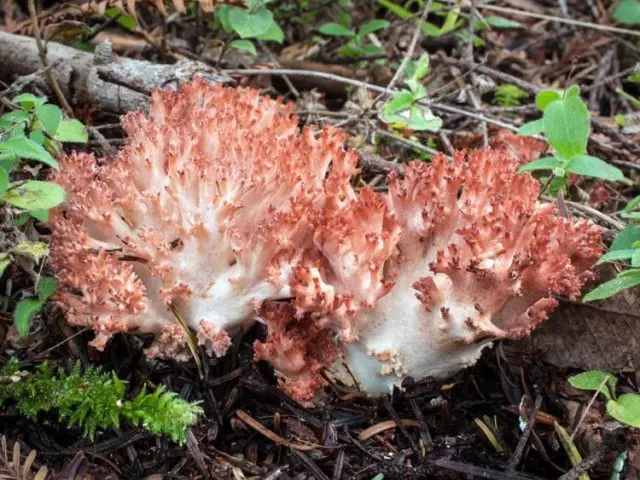
They grow up to 20 cm in height and up to 15 cm in girth. The thickness of each process reaches 1 cm. The color of the branches at a young age is pale yellow, turning brown-yellow with time, the old color is ocher or reddish-pink. The tips of the processes are always darker than the base. The flesh of the hornwort is light yellow, the mushroom is fragile and slightly watery. It has a pleasant herbal or fruity scent.
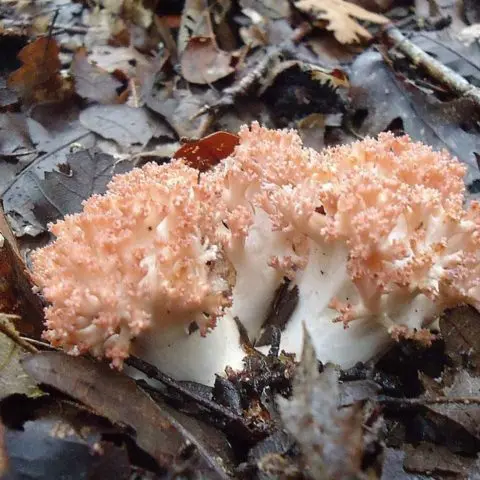
Ocher-colored oval oily spores are located on the entire surface, giving roughness to the horn.
The height of the leg is not more than 4 cm, the diameter is up to 7 cm.
Is it possible to eat grape-shaped horns
The grape-shaped horned beetle is ranked in terms of nutritional value to the fourth class, oyster mushrooms and honey agarics are also included there.
It is not recommended to pre-boil grape-like horns because of the appearance of bitterness, therefore they are fried, for example, as in Italy – entirely deep-fried.
Taste qualities of the fungus hornwort
According to the mushroom pickers, the hornwort is the most delicious of its family, with a pleasant aroma. Does not require heat treatment. It is added to salads, side dishes, soups, consumed fried.
It will not work to prepare for the winter – the horn loses its taste, becomes bitter and rubbery after 4-5 days.
Only young mushrooms are eaten, the old ones are also bitter. After frying, the horns become elastic, they taste like mushrooms. Mushrooms do not worm.
Benefits and harm to the body
Under natural conditions, finding a hornwort is a rarity. But mushrooms are grown commercially in Japan, Korea and Nepal.
Korean scientists have found that thanks to certain substances in the composition, hornwort can restore damaged liver. Medics in Nepal use a bunch-shaped mushroom for muscle pain.
In addition to its high nutritional value, hornwort has powerful antibacterial and anti-inflammatory properties, it is a strong antioxidant. An extract from it is able to stop the growth of tumors: Ehrlich carcinoma and sarcoma-180 (Crocker).
The harm from the use of grape-shaped ones lies in the individual intolerance of the constituent substances, eating can cause mild indigestion. Cases of severe poisoning by these mushrooms have not been recorded.
False doubles
Adult grape-shaped horns are outwardly similar to the following species:
- Beautiful (Beautiful) Romaria, not edible, up to 20 cm high with a thick pink stalk and yellow shoots with pinkish-yellow tips. The flesh turns red when pressed. Turns brown with age. When ingested, the fungus causes intestinal upset.

- Clavulina coral-like (comb), inedible, bitter taste. It comes in white or yellow. It grows up to 10 cm in height.

- Ramaria yellow (Yellow horns, Deer horns). It grows up to 20 cm in height, light yellow at the base and bright sunny at the tips. When you click on the mushroom, it darkens. The variety is edible, but is used for food only after soaking and heat treatment.

There are no poisonous twins among other mushrooms.
Collection rules
Only young specimens of the hornwort are collected. The old mushroom is very bitter and the taste does not improve after soaking and boiling.
You should not pick mushrooms near industrial and military facilities, railways and highways, because. they are capable of accumulating radionuclides and heavy metals. Under the ban is the collection of hornets in the territories of reserves, parks.
If there is any doubt about the edibility of a grape-like specimen, it is better not to take it.
Use
The fungus has a complex structure, the processes need to be thoroughly cleaned from branches and debris, they do it under running water. If the horns are pre-boiled (15 minutes with salt), the liquid must be drained and not used anywhere.
It is commonly sautéed with various vegetables or used in sauces, soups, salads, and side dishes.
For mushroom soup you will need:
- 1 kg of potatoes;
- 1 big carrot;
- 1 medium bulb;
- 1/2 large bell pepper;
- 15 g butter;
- salt to taste;
- 200 g of grape-shaped horns.
Cooking process:
- Peel and chop all vegetables.
- Cover potatoes with water and cook until tender.
- Fry the onion until golden brown, add carrots and peppers, fry for 10 minutes.
- Add mushrooms to onions and vegetables, fry for 10 minutes.
- Add mushrooms with vegetables, butter to a saucepan with potatoes.
- After boiling, add salt to taste and cook for another 15 minutes.
When serving, add fresh dill and a spoonful of sour cream to the finished soup.
You can fry mushrooms on their own or with vegetables and serve as an addition to mashed potatoes or porridge.
To make mushroom dishes tasty, you need to cook them immediately after picking, do not pickle or preserve, do not season the dishes with seasonings.
Conclusion
The grape-shaped horn may seem poisonous to an inexperienced mushroom picker due to its unusual appearance, which is why it is not popular. Given that the mushroom is on the verge of extinction, then it is better to refuse to collect it.










